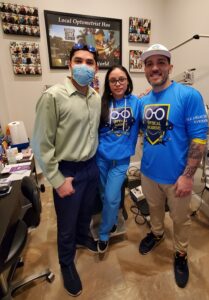
Dr. Mena, left, with two members of his practice team. Dr. Mena says that he thinks carefully about practice culture with each new hire, provides a high level of training and staff development and sets specific short- and long-term goals.
By Vittorio Mena, OD, MS
March 29, 2023
Practice ownership comes with steep leadership challenges. Here are a few key leadership lessons I learned that changed how I manage my team and interact with patients.
Create a Playbook for Your Practice with 4 Key “Plays”
We have to get into the mindset that our personal lives and business is all a game. If we have the right “plays,” we will win.
The first play in the book is to always treat people, including your staff, like you want to be treated. This is the right thing to do, and if you do not do this, you will not win. As a practice, the main goal is to provide value to patients, whether it is a few more minutes spent on patient education or directing patients to a specific style of glasses they are looking for. It also can mean directing patients to, and providing, a specialized service like myopia management, vision therapy or dry eye treatment.
The second play in the book is to create a championship winning team. That is only done by hiring employees who work well together as a team. I often see doctors posting on social media that they cannot find good help. As the business owner and captain of the ship, it is up to you to take care of the entire team and to also hire appropriately.
Your team needs to be properly trained with the appropriate resources, and they also need to feel valued for being there. If you don’t treat employees as team members or teammates, you will have zombies answering the phone or repeatedly doing mundane tasks. They will sink the ship and you will lose revenue.
On the flip side, a winning team creates raving fans (also known as happy patients) who not only continue coming back, but also tell everyone they know to visit your practice. Any problems that happen in the business are the owner’s responsibility, however you also need to bring a next-man-up approach whereby everyone in the office is accountable to make sure things go smoothly.
The third play in the book is know what your time is worth. Be mindful of the value you bring to the table and do not be afraid to charge for it. Also, do not forget about inflation. If you are not raising your fees, you will have to work harder rather than smarter.
The fourth play in the playbook is having the appropriate vision. This is best done with a mission statement. Our mission statement is, “We want you to see a beautiful day, every day!” Having an appropriate mission statement is a key way a practice can create culture. Your playbook is unlimited. Continue expanding your list to create as many “plays” as you need for success.
Adopt a Proactive, Passionate Mentality & Practice Culture
You cannot effectively lead a practice without passion. Energy and passion in a team is what creates massive momentum, and ultimately, what sells/wins. Practices frequently hire doctors or opticians based on their talents. Passion is the key. It outperforms talent or education every day of the week. Preferably you want both, but if you needed to make a decision on one, passion is king!

Dr. Mena’s team having fun together. Dr. Mena says he wants an office where employees genuinely enjoy their work.
If you have to constantly keep replacing employees or team members, you are losing productivity in the practice and adding the expense of training a new employee. To make it more likely that you hire long-lasting employees, ask potential new hires: Besides the paycheck, why do you want to work here?
It’s also a good idea to have prospective employees interviewed by current team members. That way they can see what the culture is like in the office before accepting a position. It will give them a sense of whether they would be a good fit for the office and all the people they would be working with. Sometimes it can take 1-2 hours for an interview. Other times it could be multiple days with the same person to make sure you have the right selection. Remember, it only takes one dysfunctional person to sink a ship or mess up a game plan, so take your time.
Author Simon Sinek refers to the “Golden Circle” in which people typically buy into from the “why” you do things in the practice. Then comes the “how” and then the “what.” Your “why,” which is the center ring, is your passion and values. Your “how,” the middle ring, is your work traits and how you and your team execute things. Your “what,” the outer ring, is your products, skills and services. When you have staff believing in your why, the better your business will perform.
Set Short-Term & Long-Term Goals
For goals to work, they need to be written down, specific, measurable and with a time limit. To hit a goal, you need to have a written game plan or blueprint.
Other Articles to Explore
For example, “I want to make more money in my practice” is a great thought, but not specific enough. How much do you want to make? By when? What do you need to do to generate that specific amount?
Let’s pretend an optician or sales associate makes commissions selling glasses and lens treatments, and wants to make an extra $10,000 for an entire year. So far, they created a goal and even gave it a time limit of one year. Let’s say every lens treatment and frame they sell gives them $2 each (Example: scratch treatment $2, polycarbonate $2, anti-reflective treatment $2, UV tint $2 and glasses $2). If they sold a pair of glasses with four lens treatments to a patient, that optician/sales associate would get a commission of $10. Assuming they work five days a week to hit $10,000 for an entire year, they would have to sell a pair of glasses and four lens treatments to just four patients a day: $10 x 4 patients a day = $40; $40 x 5 days a week = $200; $200 per week x 50 weeks (assuming two weeks off for vacation) = $10,000. Bi-weekly the goal could be broken down as: $400 (2 weeks commission) x 25 weeks (two weeks off for vacation) = $10,000.
Either way, if the optician/sales associate wanted to make more money on commission, they would have to add more lens treatments, sell to more than four patients a day or sell 2-3 pairs to a single patient. The more glasses they sell the more money the practice makes and the more everyone wins.
These math/goal scenarios work for every part of your practice, whether you sell nutritional supplements, dry eye therapies, specialty contacts lenses, or any other product. In our office, our practice growth in both patients and also in employees had grown by 10 percent by the end of 2022. By using the strategies I discussed above, I hope to have it grow another 10-15 percent in 2023.
Bottom Line: Always remember, the business owner is the coach of the team. Life is a game and the coach first needs to have goals in place for their players to work toward. In the end, it is a team game with one shared mission. Results are ultimately produced by being proactive. Best of luck to you all on your journeys, and keep grinding out there!
 Vittorio Mena OD, MS, is the sports vision director with Optical Academy. To contact him:menavitt@gmail.com
Vittorio Mena OD, MS, is the sports vision director with Optical Academy. To contact him:menavitt@gmail.com

























